Click on images to enlarge

infestation (Photo: Sheldon Navie)

infestation in a lawn (Photo: Sheldon Navie)

habit (Photo: Sheldon Navie)
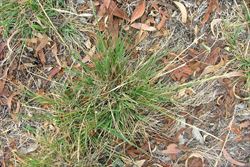
habit (Photo: Sheldon Navie)
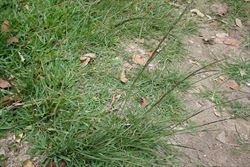
long and narrow seed-heads (Photo: Sheldon Navie)
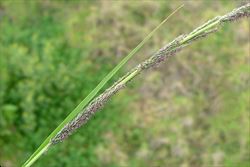
upper leaf and lower part of seed-head (Photo: Sheldon Navie)
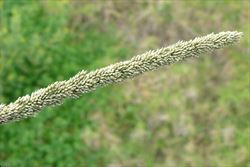
upper part of seed-head (Photo: Sheldon Navie)
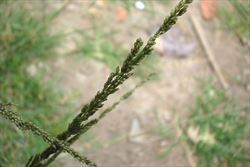
close-up of young seed-head (Photo: Sheldon Navie)
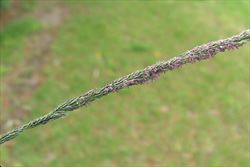
seed-head in flower (Photo: Sheldon Navie)
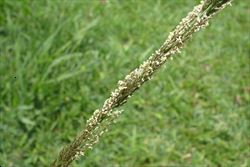
close-up of seed-head in flower (Photo: Sheldon Navie)
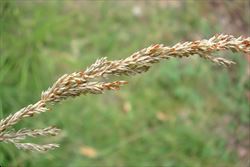
close-up of mature seed-head with seeds (Photo: Sheldon Navie)
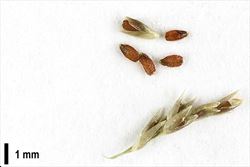
close-up of mature flower spikelets and seeds (Photo: Sangita Shrestha)
Scientific Name
Sporobolus africanus (Poir.) Robyns & Tourn.
Synonyms
Agrostis africana Poir.Agrostis capensis Willd.Agrostis spicata Thunb.Sporobolus capensis (Willd.) KunthSporobolus indicus (L.) R. Br. (misapplied)Sporobolus indicus (L.) R. Br. var. africanus (Poir.) Jovet & GuedesSporobolus indicus (L.) R. Br. var. capensis Engelm.Vilfa africana (Poir.) P. Beauv.Vilfa capensis P. Beauv.
Family
Gramineae (South Australia)Poaceae (Queensland, New South Wales, the ACT, Victoria, Tasmania, Western Australia and the Northern Territory)
Common Names
African dropseed, African dropseed grass, dropseed grass, Indian rat's tail grass, Parramatta grass, rat tail grass, rat's tail, rat's tail grass, rats' tails, ratstail, ratstail dropseed, rattail dropseed, rat-tail grass, rattail grass, rattailgrass, rush grass, smut grass, smutgrass, tough dropseed, tufty grass, tussock grass
Origin
Native to southern and eastern Africa (i.e. Ethiopia, Kenya, Tanzania, Uganda, Cameroon, Malawi, Mozambique, Zambia, Zimbabwe, Lesotho, Swaziland and South Africa).
Naturalised Distribution
This species is widely naturalised in Australia, particularly in the southern and eastern parts of the country. It is most common in the coastal regions of Victoria, New South Wales and southern Queensland, and is also reasonably common in south-eastern South Australia and south-western Western Australia. Scattered populations occur in Tasmania, the ACT, the Northern Territory and northern Queensland.
Also naturalised on Lord Howe Island and Norfolk Island, in New Zealand, and in other parts of the Pacific (i.e. in French Polynesia, Niue and Hawaii).
Habitat
A weed of lawns, footpaths, parks, roadsides, disturbed sites, waste areas, swamps, grasslands, open woodlands and pastures in temperate, sub-tropical and occasionally also tropical regions. It is particularly common in areas with compacted soils.
Habit
An upright (i.e. erect) and tufted or tussocky long-lived (i.e. perennial) grass usually growing 15-50 cm tall, but occasionally reaching up to 110 cm in height.
Distinguishing Features
- an upright and tufted long-lived grass with wiry flowering stems usually growing 15-50 cm tall.
- its long and narrow leaf blades (6-40 cm long and 1-4 mm wide) may be flat or somewhat rolled.
- its seed-heads are also very thin and elongated in appearance (6-35 cm long and 4-7 mm wide).
- they have many short branches (10-20 mm long) that are held closely to the main stem.
- each of these branches bears numerous small flower spikelets (2-2.8 mm long).
Stems and Leaves
The hairless (i.e. glabrous) flowering stems (i.e. culms) are slender (1.5-3 mm thick), but somewhat wiry, and are usually not branched.
The alternately arranged leaves are very thin (i.e. linear) and consist of a leaf sheath, which partially encloses the stem, and a spreading leaf blade. The leaf sheaths (4-12 cm long) are slightly hairy (i.e. sparsely pilose) or hairless (i.e. glabrous) and the lower ones become somewhat papery with age. The leaf blades (6-40 cm long and 1-5 mm wide) may be either flat or somewhat rolled (i.e. weakly convolute). They are hairless (i.e. glabrous) and have pointed tips (i.e. acuminate apices). Where the leaf sheath meets the leaf blade there is a fringe of tiny hairs (i.e. ciliated ligule) or a tiny membrane (0.1-0.3 mm long) topped with hairs (i.e. ciliated membrane).
Flowers and Fruit
The dark green, dark grey or greyish-green coloured seed-heads, which are borne at the top of the flowering stems (i.e. culms), are very thin and elongated in appearance (6-35 cm long and 3-8 mm wide). They are upright (i.e. erect), spike-like (i.e. spiciform panicles), and have many short branches (10-20 mm long) that are held very closely (i.e. appressed) to the main stem of the seed-head. These branches are quite densely arranged along the stem and are only sometimes interrupted near the base of the seed-head. Each of these seed-head branches bears numerous tiny, densely packed, flower spikelets almost to its base. The elongated (i.e. lanceolate) or egg-shaped (i.e. ovate) flower spikelets (2-2.8 mm long and 0.6-0.8 mm wide) contain a single tiny flower (i.e. floret) inside two bracts (i.e. glumes). The lower bract (i.e. glume) is 0.4-0.7 mm long and the upper bract (i.e. glume) is 1-1.5 mm long (i.e. at least half the length of the flower spikelet). Flowering occurs throughout the year, but is most abundant from spring through to late autumn (i.e. from October to June).
The oblong, oval-shaped (i.e. ellipsoid), or almost rounded (i.e. sub-globular) 'seeds' (i.e. grains or caryopses) turn dark red or reddish-brown in colour as they mature. They are tiny (1.1-1.5 mm long and up to 0.6 mm wide) and separate from the remainder of the flower spikelet at maturity (i.e. the whitish-coloured old glumes remain on the seed-head).
Reproduction and Dispersal
This species produces large quantities of tiny seeds.
These seeds are sticky when wet and readily become attached to animals, clothing and vehicles. They may also be dispersed by water, in mud, and in contaminated agricultural produce (e.g. in fodder and pasture seed lots).
Environmental Impact
Parramatta grass (Sporobolus africanus) is regarded as an environmental weed in Queensland and New South Wales, and was recently listed as a priority environmental weed in two Natural Resource Management regions.
Legislation
This species is declared under legislation in the following states and territories:
- Queensland: Class 2 - landowners must take all reasonable steps to keep land free of this species (throughout the entire state). It is also illegal to sell a declared plant or its seed in this state.
- Western Australia: Unassessed - this species is declared in other states or territories and is prohibited until assessed via a weed risk assessment (throughout the entire state).
Management
For information on the management of this species see the following resources:
- the Biosecurity Queensland Fact Sheet on giant rats tail grass and other weedy Sporobolus species, which is available online at http://www.dpi.qld.gov.au.
Similar Species
Parramatta grass (Sporobolus africanus ) is very similar to other introduced rats-tail grasses (Sporobolus spp.), including giant Parramatta grass (Sporobolus fertilis ), American rats-tail grass (Sporobolus jacquemontii ), and the giant rats-tail grasses (Sporobolus pyramidalis and Sporobolus natalensis ). It is also similar to some native species such as the slender rats-tail grasses (Sporobolus creber and Sporobolus elongatus). Distinguishing between these species is often very difficult and a specialist may need to be consulted, however the following is a guide to the differences that may be apparent:
- Parramatta grass (Sporobolus africanus) is a relatively small plant (usually less than 50 cm tall) with relatively small spike-like (i.e. spiciform) seed-heads (6-35 cm long). These seed-heads have numerous short branches (10-20 mm long) that are usually held closely (i.e. appressed) to the main stem. These branches are normally densely arranged and the seed-head is mostly un-interrupted (except occasionally at the base). Its flower spikelets are relatively large (2-2.8 mm long).
- giant Parramatta grass (Sporobolus fertilis) is a relatively large plant (usually 80-160 cm tall) with relatively large spike-like (i.e. spiciform) seed-heads (15-50 cm long). These seed-heads have numerous moderately long branches (20-80 mm long) that are held closely (i.e. appressed) to the main stem or are slightly spreading. These branches are normally densely arranged and the seed-head is mostly un-interrupted (except occasionally at the base). Its flower spikelets are relatively small (1.5-2 mm long).
- American rats-tail grass (Sporobolus jacquemontii) is a moderately-sized plant (usually 50-75 cm tall) with relatively small elongated seed-heads (8-25 cm long). These seed-heads have numerous relatively long branches (50-100 mm long) that usually spread away from the main stem. These branches are normally densely arranged and the seed-head is un-interrupted. Its flower spikelets are relatively small (1.5-2 mm long).
- giant rats-tail grass (Sporobolus pyramidalis) is a relatively large plant (usually 90-200 cm tall) with relatively large pyramid-shaped (i.e. pyramidal) seed-heads (20-45 cm long). These seed-heads have numerous relatively long branches (50-100 mm long) that stiffly spread away from the main stem when fully open. Its flower spikelets are moderately-sized (1.7-2.2 mm long).
- giant rats-tail grass (Sporobolus natalensis) is a relatively large plant (60-150 cm tall) with relatively large spike-like (i.e. spiciform) seed-heads (20-30 cm long). These seed-heads have numerous relatively long branches (30-70 mm long) that usually spread away from the main stem. These branches are normally densely arranged and the seed-head is un-interrupted. Its flower spikelets are moderately-sized (1.6-2.3 mm long).
- slender rats-tail grass (Sporobolus creber) is a moderately-sized plant (usually less than 100 cm tall) with relatively long and very narrow spike-like (i.e. spiciform) seed-heads (18-60 cm long). These seed-heads have numerous short stiff branches (5-10 mm long) that are always held closely (i.e. appressed) to the main stem. These branches are normally widely spaced and the seed-head is interrupted (except near the top). Its flower spikelets are relatively small (1.2-1.7 mm long).
- slender rats-tail grass (Sporobolus elongatus) is a moderately-sized plant (usually 50-100 cm tall) with relatively long and narrow spike-like (i.e. spiciform) seed-heads (10-30 cm long). These seed-heads have numerous relatively long branches (40-80 mm long) that are usually held closely (i.e. appressed) to the main stem (sometimes slightly spreading). These branches are normally densely arranged and the seed-head is mostly un-interrupted (except occasionally at the base). Its flower spikelets are moderately-sized (1.5-2.3 mm long).

